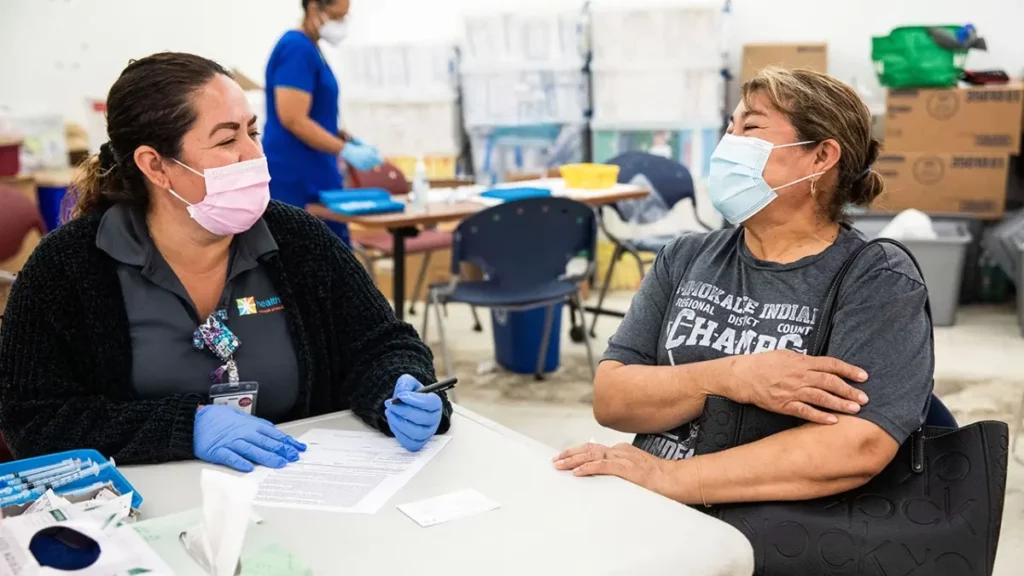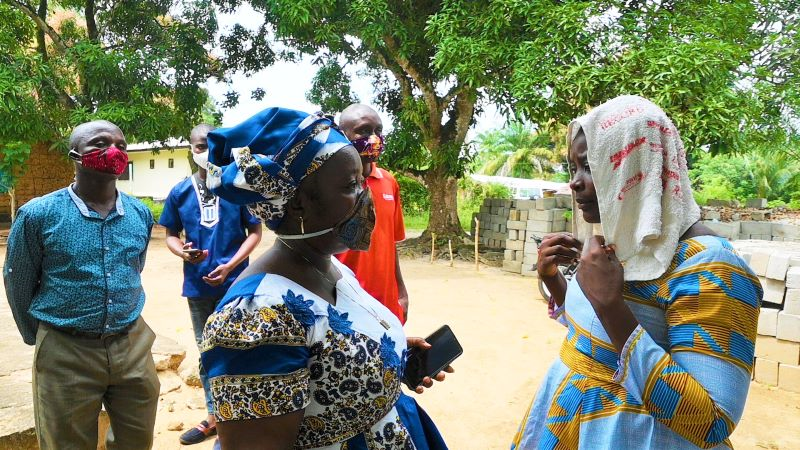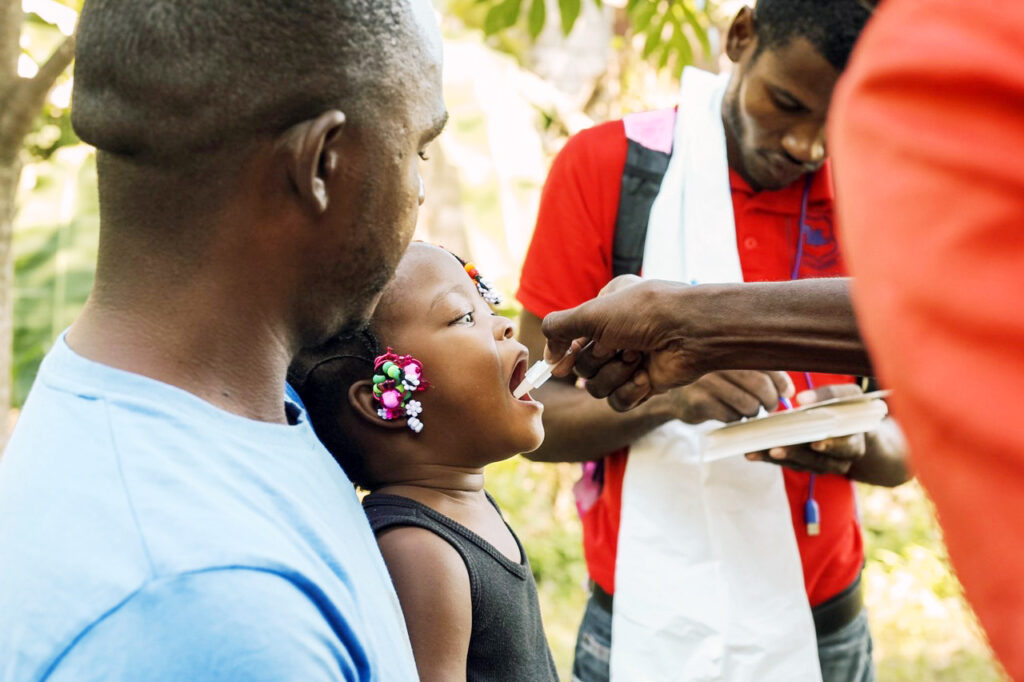Omicron and COVID-19 Vaccination: Fact vs. Fiction

PIH experts debunk myths about the newest COVID-19 variant and the power of global vaccination
Posted on Jan 27, 2022

The Omicron variant of the coronavirus is driving caseloads to record highs and filling hospitals to capacity. With over 300 million cases of COVID-19 worldwide and more than 5.5 million deaths, doctors and other medical personnel are physically and emotionally drained, and the public is weary and desperate for a glimpse of the pandemic’s end. This bleak landscape has given rise to numerous myths about Omicron, which was first identified by the WHO as “a variant of concern” in November 2021 and now accounts for most cases globally. We sat down with three senior advisors at Partners In Health to try to bust some Omicron myths and gain perspective.
Dr. KJ Seung is a senior health and policy advisor at PIH and an associate physician at Brigham & Women’s Hospital; Dr. Emily Wroe is an internist and global and public health specialist, currently serving as a senior advisor for PIH’s U.S. COVID-19 response; and Dr. Paul Sonenthal is a pulmonary and critical care physician at Brigham & Women’s Hospital and the associate director for inpatient medicine and critical care at PIH. They are all affiliated with Harvard Medical School. Our interview has been edited and condensed.
There is a strong narrative out there that Omicron is mild. What is your response to this widespread point of view?
We think that people championing this position are primarily speaking from a position of privilege and thinking about their personal risk. If you have access to everything that protects you from bad outcomes—vaccines and boosters readily available and access to medical care, and if you are relatively healthy with no comorbidities— then for your own personal risk, Omicron can appear somewhat less severe than previous variants.
However, most of the global south remains unvaccinated, and many people worldwide have chronic health conditions and limited access to care. For most of the world, nothing about this surge is “mild.” As we pursue an equitable pandemic response, we need to not simply account for the privileged, but focus on tried-and-true public health and clinical tools, ensuring they are accessible to communities everywhere. Rather than giving up, we should double down on global vaccination, testing and treatment, contact tracing, masking, and other prevention measures.
But beyond an equity lens, the first key thing to understand about Omicron is that “milder” (compared to the Delta variant) does not equal “mild.” Delta was a bad disease, and so is Omicron. A staggering number of people are hospitalized and having complications, and while this is worse in the unvaccinated or immunocompromised, even those who are vaccinated can have bad outcomes from Omicron.
What is happening now is the story of COVID-19 since the beginning: things move fast, people hear a few things from a few people, or they hear rumors, and take them as truth. The plural of anecdotes is not evidence.
Can you talk more about the societal implications of declaring Omicron less severe than other variants?
Even if something is milder for one person, that is not the same as mild for society.
Hospitals are collapsing with cases, ICUs are full. As of mid-January, many hospital systems, including those in rich countries like the United States, are at full capacity, and more will surely reach that in the next weeks. U.S. President Joe Biden is sending military response teams to six states: Michigan, New Mexico, New York, New Jersey, Ohio, and Rhode Island to help deal with this extreme surge. And multiple U.S. states are calling in the National Guard to bolster hospital staff.
There are still huge numbers of infections, including children too young to be vaccinated, hospitals are at a pandemic peak, and many people are at risk. This is not a measured disease; any other infection that behaved this way, we would never call it mild—mild devalues what is happening in society. As a recent article in The Atlantic said: “When Omicron finds vulnerable hosts, it can still exact SARS-CoV-2’s worst. And Omicron is finding them.”
People also need to remember that COVID-19 can have long-term consequences. We’re still learning about long COVID-19, but anywhere from 5% up to almost 50% of cases can have symptoms and effects of COVID-19 for several months after the acute illness. That is a huge number of people worldwide that may end up suffering from a new chronic illness—a substantial burden and cost to patients and health systems.
A cluster of interconnected myths out there suggest that COVID-19 will end in the U.S. soon and that the U.S. has already done as much as it can. There is nothing anyone can do to avoid Omicron and everyone will get it, so why not just get infected and have it over with.
There is so much that is wrong with this. First of all, we don’t know how long immunity will last, nor do we know what variants will emerge next—and, critically, all of this spread now means more viral replication, which means more chance for new variants. We have no guarantee that we won’t have a horrible variant coming at us again in a few months, and allowing unmitigated spread like this increases the chance of that. It’s not a good approach to put all of our faith in ‘herd immunity’ or the idea that ‘this will be endemic, just like seasonal flu.’ Might the next variant cause more severe illness? Might it be better at escaping the protection of our vaccines and past infections? We simply don’t know.
Even in this moment, we must not adopt a nihilistic, defeatist approach. Stating that everyone will get this is morally unacceptable; there would be way too many deaths, complications from being sick, and costs to individuals and society.
We need to proceed with optimism and remain committed to the many tools we have available that we know are effective for people and communities. That includes getting vaccinated and boosted, wearing good masks (N95 or KN95), isolating immediately if symptoms arise, avoiding crowded and indoor events, and using rapid tests when symptomatic and before any group events. We also need better access to oral therapies, improved ventilation systems, and labour protections like paid leave. And, urgently, we need to vaccinate the rest of the world. A new report by PIH and partners says we need 22 billion mRNA vaccines to control COVID-19.
In response to the idea that the U.S. has already done what it can to fight the pandemic, this encapsulates the perspective of the individual versus the collective. The individual perspective about protecting yourself (for instance, the U.S. and Europe sucking up all the resources with little to nothing left for the global south) is hollow because the virus and its variants don’t respect borders. If we don’t approach this collectively…we wind up with the kinds of grave double standards we now have. It is tiring to think of the work we need to continue to do to fight COVID-19, but if we don’t, in the end, it’s going to bite us.

This is related, but there is also a sense that COVID-19 is mild, or not as serious, in Africa.
We have little information, and the information we do have is not encouraging and suggests the opposite—that COVID-19 is just as serious in Africa. For example, the death rate and the number of excess deaths in South Africa do not support this theory at all. This is a claim without any basis in data, and it’s one we would never be able to make in the current situation, which is that the large majority of the continent hasn’t even had access to testing (only 1 in 7 cases detected, only 1 in 20 people ever tested). We also know there has been a massive negative impact in Africa on the prevention and treatment of TB and HIV as patients, fearful of contracting COVID-19, stay away from clinics and hospitals and health systems are interrupted by the virus.
How about this myth: Many people in Africa are vaccine hesitant—they just won’t accept the vaccine.
The question is, hesitant to what? First, they may not be hesitant to mRNA vaccines but hesitant to some of the vaccines out there that are not effective or have bad side effects. A lot of people are not happy about getting second-tier vaccines. Second, there are reasons not to trust health systems in the U.S. and in other countries historically.
Research shows that vaccine acceptance rates in Africa are actually quite high, as does experience. There are of course some pockets of hesitancy or skepticism—as there is everywhere—and this is rooted in colonialism and histories of unethical practices and extraction.
The most important and effective way to build trust—in any health program—is to deliver good health services. The health system needs to be a place that is equipped and staffed to help people; when they are sick they can come and get a diagnosis and treatment.
What about this idea that there’s no point in contact tracing because Omicron is spreading too fast?
We have to keep in mind that many of the messages out there may be rooted in scarcity or in politics. The reason people are saying contact tracing doesn’t make sense is really about our public health system capacity. There are too many cases for public health systems to trace right now. But that doesn’t mean that contact tracing isn’t important in pandemic response or that it isn’t possible. In reality, contact tracing for Omicron is really similar to contact tracing for Delta and the early pandemic.
Many places can and continue to contact trace, and public health officials are adjusting approaches based on how many cases they have and their capacity to do contact tracing. Again, this is a human resource issue, not something about the virus. For example, in some places where it is not possible to call everyone, they have been focusing on at-risk individuals or communities or prioritizing identifying clusters to support outbreak response.
As hospitals fill up, there’s a feeling that other illnesses—not COVID-19—might be driving this trend. The idea is that, when it comes to Omicron, people are only hospitalized with COVID-19, not for COVID-19.
Think about what it takes to get someone sick enough to go to the hospital. Delta alone may have been necessary and sufficient to send someone to the hospital; maybe Omicron is not sufficient, but it is necessary. For example, maybe it’s someone with diabetic ketoacidosis, but Omicron was the tipping point. Hospitals may have different diagnoses or coding, but the reason that person is in the hospital is driven by COVID-19. Hospitals are at capacity; there’s something driving those hospitalizations. And there are many complex ways COVID-19 can drive hospitalizations.
People are tired of the pandemic—they want some certainty— and to hear something hopeful, that this is nearing the end. We are not at that point. Three weeks ago, the Brigham [and Women’s Hospital in Boston] ran out of ICU beds—something’s driving that. People have begun to question the hospitals; it’s part of the denial process. But they are disregarding the testimony of people in the hospital who are seeing this with their own eyes. If hospitals aren’t overburdened, why call in the National Guard?
I’ve also heard that manufacturing vaccines is too difficult to pull off for anyone but Pfizer and Moderna.
This is just an excuse. “This is too hard,” is one of many excuses we often hear in global health. Just like other excuses such as, “We can’t manufacture enough,” or, with some of the medicines you have to take soon after symptoms, “It’s just too hard, patients present too late.” The response to all of this is, “No, let’s not drive a pandemic response through a system rooted in capitalism and racism. Let’s do the hard work instead.” Again, it’s a double standard.
Double standards are unfortunately all too common in global health. For example, we are boosting the U.S. and Europe but the majority of the global south isn’t vaccinated, a trend in danger of continuing.
The HIV movement saw these excuses and double standards time and time again—in fact, at the beginning, it was claimed that Africans couldn’t take HIV treatment because they didn’t have watches and couldn’t tell time. These sorts of excuses during COVID-19 are different versions of the lack of watches argument.
This is all quite discouraging. Are there any silver linings here?
Well, everyone agrees we get hopeful seeing all our colleagues in PIH-supported health facilities who get up and go to work every day despite the challenges. The fact that people are still picking themselves off the ground and going forward means there is potential for a collective response.
Originally published on pih.org
AT PIH, we believe that no one is safe from COVID-19 until everyone is safe. A COVID-19 survivor in Peru recounts fear amid the pandemic, chronic disease, food, and housing insecurity.



